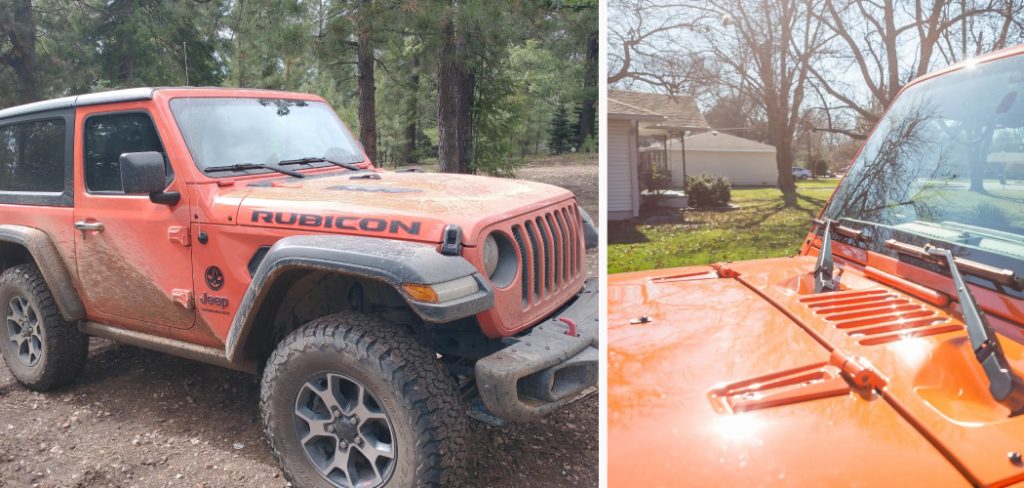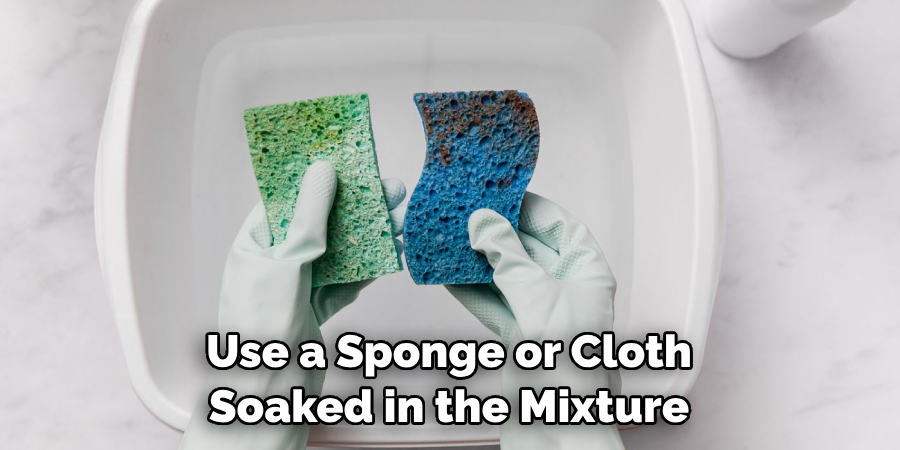Have you ever experienced the annoying stickiness of tree sap on your car’s windshield? Do you have trouble removing this viscous substance? Tree sap not only mars your windshield’s appearance but can also obstruct vision, leading to hazardous driving conditions. Worry no more because we’ve got you covered! In this ultimate guide, we will provide practical methods on how to remove sap from windshield effectively and safely.

Can You Remove Sap from The Windshield?
There’s nothing quite like the feeling of cruising down the road, wind in your hair, and a clear view of the world around you. That is until you notice that pesky sap is clinging to your windshield.
It’s a problem that has plagued drivers for generations, but there is a solution. With a little elbow grease and the right tools, you can remove sap from your windshield and get back to enjoying the open road. So don’t let a few sticky spots ruin your day. Take charge and get your windshield back in tip-top shape. Your future self (and your eyes) will thank you for it!
Why Should You Remove Sap from The Windshield?
Have you ever driven down a wooded road and found your windshield covered in sticky sap? It’s an unsightly mess and can impair your visibility while driving. Removing sap from your windshield is crucial to keeping yourself and others on the road safe. Plus, leaving sap on your windshield can harm your car’s paint job and cause lasting damage.
Don’t wait until the sap hardens or further obscures your view. Take the time to properly clean it off and drive confidently with a clear windshield and a clearer mind.
Say Goodbye to Sticky Problems: The Ultimate Guide on How to Remove Sap from Windshield
Method 1: Use Soap and Water
The most basic method to remove tree sap from your windshield is using soap and water. First, mix some dish soap with warm water then use a sponge or cloth soaked in the mixture to wet the affected area. Rub the surface gently using some pressure until all the sap has been removed. Rinse the windshield with clean water and dry it with a soft cloth.

Method 2: Rubbing Alcohol
Another useful cleaning agent to remove tree sap is rubbing alcohol. Moisten a microfiber cloth with rubbing alcohol and use it to rub the sap gently. Keep rubbing until the sap is dissolved or loosened. Use a dry microfiber cloth to wipe off the sap residue and any remaining traces of alcohol.
Method 3: WD-40
WD-40 is a versatile household item that can also remove tree sap from your windshield. Spray a bit of WD-40 behind an opaque tape that covers the sap. Wait for five minutes, then remove the tape and wipe the sap away with a microfiber cloth. Rinse the windshield with some water and wipe it again with a clean cloth.
Method 4: Cooking Oil
Believe it or not, cooking oil is another cleaning agent you can use as a substitute for WD-40. Soak a soft cloth with some cooking oil and dab it onto the sap. Wait for a couple of minutes and let the oil soften the sap. Then, wipe it off with a clean cloth. Once done, wash the windshield with some soap and water and dry it with a soft cloth.

Method 5: Vinegar
Vinegar is a natural cleaning agent that can also remove tree sap from your windshield. Dilute one cup of white vinegar in one cup of water, moisten a microfiber cloth with the solution, and rub it onto the sap. Leave it for a few minutes and let the vinegar dissolve the sap. Wipe the sap and any residue off with a clean, dry microfiber cloth. Finally, wash the windshield with soap and water and dry it with a soft cloth.
Method 6: Commercial Sap Removers
If you don’t have any of the above-mentioned solutions at hand, there are also commercial sap removers available in the market. These products are specially designed to remove tree sap from cars without damaging the paint or windshield. Follow the instructions on the product and use it as directed.
Method 7: Professional Cleaning
If none of the above methods work or if you want to save time, you can always seek professional help. There are many car detailing shops that offer windshield cleaning services at an affordable price. They have specialized tools and solutions to remove tree sap effectively without causing any harm to your car’s exterior. Just make sure to choose a reputable and reliable service provider for the best results.
5 Considerations Things When You Need to Remove Sap from Windshield
1. Temperature
The temperature outside can greatly affect the removal of sap from a windshield. If it is too hot, the sap may become more sticky and difficult to remove. On the other hand, if it is too cold, the sap may harden and become even harder to remove. It is best to try and remove sap when the temperature is moderate, around 60-70 degrees Fahrenheit.
2. Type of Sap
There are different types of tree sap that can fall onto your windshield, such as pine sap or maple sap. Each type may require a different removal method. For example, pine sap can be removed with rubbing alcohol or hand sanitizer, while maple sap may require a mixture of baking soda and water.
3. Tools
Having the right tools can make all the difference when removing sap from a windshield. Some useful tools include a razor blade or plastic scraper for scraping off hardened sap, rubbing alcohol for dissolving sticky residue, and a microfiber cloth for wiping away any remaining debris.
4. Time
Removing sap from a windshield may take some time and patience. It is important not to rush the process as it could damage your windshield or leave behind residue. Take your time and use gentle motions when removing the sap.

5. Prevention
Prevention is key when it comes to keeping your windshield free from tree sap. Consider parking in shaded areas or using a car cover to protect your car from falling tree debris. Regularly washing your car can also help prevent the buildup of tree sap on your windshield.
5 Benefits of Removing Sap from Windshield
1. Improved Visibility
One of the main benefits of removing sap from your windshield is improved visibility while driving. Sap can create a hazy film on your windshield, making it difficult to see clearly, especially in bright sunlight or at night. This can be dangerous and increase the risk of accidents on the road.
2. Protection for Your Windshield
Sap contains acidic properties that can damage your windshield over time if left untreated. It can cause etching and pitting, which weakens the glass and makes it more susceptible to cracks and chips. By regularly removing sap from your windshield, you are protecting it from potential long-term damage.
3. Better Wiper Blade Performance
Sap can also affect the performance of your windshield wipers. When sap builds up on your windshield, it can make your wiper blades less effective in clearing away rain or debris, causing streaks and smears on your windshield. Removing sap will ensure that your wiper blades are able to do their job properly.
4. Improved Aesthetic Appearance
Let’s face it – a car with a clean and clear windshield just looks better than one with a sticky, messy layer of sap covering it. By regularly removing sap from your windshield, you are not only improving its functionality but also enhancing its overall appearance.
5. Preventing Further Damage
If left unattended for too long, the sap can harden and become even more difficult to remove from your windshield. This may require more aggressive cleaning methods that could potentially scratch or damage the glass surface. By regularly removing sap, you are preventing it from becoming a bigger problem down the road.

Some Common Mistakes People Make When Trying to Remove Sap from Windshield
Driving through a forested area can be a refreshing experience. Still, it can also lead to frustrating consequences, especially if you drive through some sap that may have landed on your windshield. Removing sap from your car’s windshield may seem like an easy job, but it can be quite tricky if you don’t know what you’re doing.
Using the wrong technique or product can cause scratches or damage to the windshield. Some common mistakes people often make when trying to remove sap from their windshield include using a razor blade, scrubbing too hard, or using harsh chemicals that could damage under layers of glass. However, with the right information and techniques, you can make removing sap from your windshield a breeze.
Conclusion
In conclusion, removing tree sap from your windshield can be frustrating, but with these practical methods, you can effectively and safely remove it. Soap and water, rubbing alcohol, WD-40, cooking oil, and vinegar are cleaning agents that can be easily found in your household and can effectively help you solve this sticky problem.
Remember to use clean microfiber cloths and gentle movements to avoid scratching your windshield’s surface when cleaning and wiping. Say goodbye to sticky problems and hello to crystal-clear windshield views! Thanks for reading our post about how to remove sap from windshield.

About
JeepFixes Team is a skilled author for Jeep Fixes, bringing 6 years of expertise in crafting a wide range of jeep fixes. With a strong background in jeep fixes work, JeepFixes Team’s knowledge spans various types of fixtures, from decorative pieces to functional hardware, blending precision with creativity. His passion for jeep fixes and design has made him a trusted resource in the industry.
Professional Focus:
Expert in Jeep Fixes : JeepFixes Team aesthetic specializes in creating durable and innovative jeep fixes, offering both appeal and functionality. His work reflects a deep understanding of jeep fixes techniques and materials.
Sustainability Advocate : He is dedicated to using sustainable practices, ensuring that every fixture is crafted with eco-friendly methods while maintaining high-quality standards.
In his writing for jeep fixes, JeepFixes Team provides valuable insights into the latest trends, techniques, and practical advice for those passionate about jeep fixes, whether they are professionals or DIY enthusiasts. His focus on combining artistry with engineering helps others discover the true potential of jeep in design.
